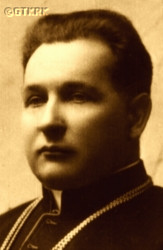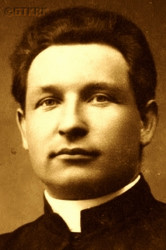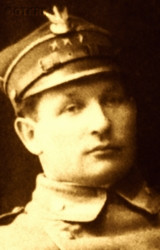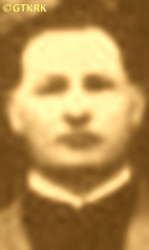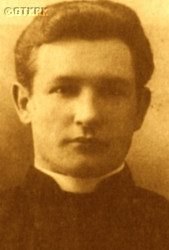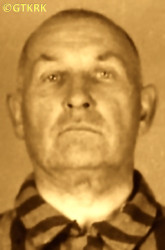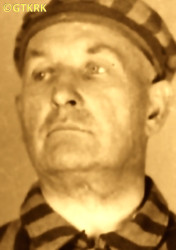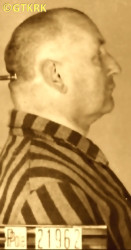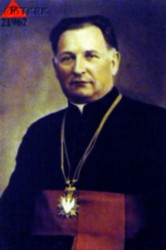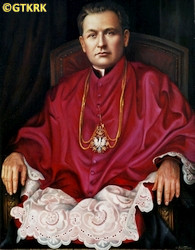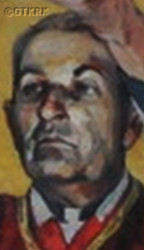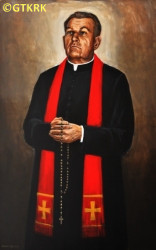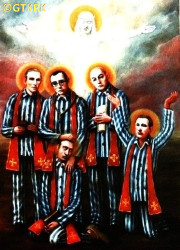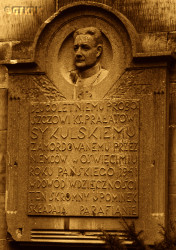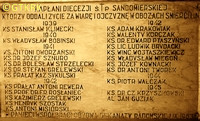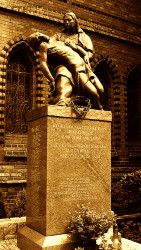Roman Catholic
St Sigismund parish
05-507 Słomczyn
85 Wiślana Str.
Konstancin deanery
Warsaw archdiocese, Poland
full list:
displayClick to display full list

searchClick to search full list by categories
wyświetlKliknij by wyświetlić pełną listę po polsku

szukajKliknij by przeszukać listę wg kategorii po polsku

Martyrology of the clergy — Poland
XX century (1914 – 1989)
personal data
religious status
blessed
surname
SYKULSKI
forename(s)
Casimir Thomas (pl. Kazimierz Tomasz)
beatification date
13.06.1999more on
www.swzygmunt.knc.pl
[access: 2013.05.19]

the RC Pope John Paul IImore on
en.wikipedia.org
[access: 2014.09.21]
function
diocesan priest
creed
Latin (Roman Catholic) Church RCmore on
en.wikipedia.org
[access: 2014.09.21]
diocese / province
Sandomierz diocesemore on
en.wikipedia.org
[access: 2013.05.19]
RC Military Ordinariate of Polandmore on
en.wikipedia.org
[access: 2014.12.20]
academic distinctions
Sacred Theology Candidate
honorary titles
Prelate‐dean (Lat. praelati‐decanus)more on
Prelate—dean (Lat. praelati—decanus)
(02.1938, St Martin the Bishop and Confessor RC collegiate church, Opatówtoday: Opatów gm., Opatów pov., Holy Cross voiv., Poland
more on
en.wikipedia.org
[access: 2021.07.18])
Minor Canonmore on
Minor Canon
(10.09.1926, St Martin the Bishop and Confessor RC collegiate church, Opatówtoday: Opatów gm., Opatów pov., Holy Cross voiv., Poland
more on
en.wikipedia.org
[access: 2021.07.18])
Papal chamberlainmore on
Papal chamberlain
(19.08.1922)
Gold „Cross of Merit”more on
Gold „Cross of Merit”
(03.12.1938)
War Order of Virtuti Militari — Silver (5th Class)more on
War Order of Virtuti Militari – Silver (5th Class)
(15.02.1946)
„In the Penitentiary Service” Badge — goldenmore on
„In the Penitentiary Service” Badge – golden
(08.06.2016)
date and place
of death
11.12.1941

KL Auschwitzconcentration camp
today: Oświęcim, Oświęcim gm., Oświęcim pov., Lesser Poland voiv., Poland
more on
en.wikipedia.org
[access: 2022.01.09]
details of death
In 1920, during the Polish–Russian war of 1919‐1921, volunteered as auxiliary chaplain of the Polish Army. Prob. took part in the Battle of Warsaw on c. 15.09.1919 (known as the „Miracle on the Vistula”), when the Poles stopped the Russian offensive, defeated the Russians, and forced them to withdraw.
After the German invasion of the Republic of Poland on 01.09.1939 (the Russians attacked Poland 17 days later) and the beginning of World War II, during the bombing of the Końskie town on 04.09.1939 by German aircrafts, took the so‐called bursa with Holy Communion and oils around his neck and walked the streets looking for the wounded and sick, serving them, helping to transport them to the hospital.
Four days later, on 08.09.1939, when the Germans entered Końskie, was arrested by the Germans for the first time and held hostage — threatened with death in the event of armed resistance from the residents.
Released It is not known whether was still being held when on 12.09.1939 in the square by the collegiate church of St Nicholas, where was a parish priest, the Germans rounded up about 40‐50 Jewish men and ordered them to dig graves for 4 German soldiers who had died fighting the Polish army. The moment they were released, a German military vehicle drove onto the square. Its driver, at the sight of the large group of men — prob. thought they were Poles: this is what Leni Riefenstahl, a famous German film director and witness to the event, claimed — opened fire with a submachine gun. 22 Jews were killed.
After German and Russian invasion of Poland in 09.1939 and start of the World War II, after start of German occupation, for the first time arrested by the Germans on 08.09.1939 and held as a hostage.
Released.
Second time arrested by the Germans on 08.11.1939 — and again held as a hostage — a few days before the Polish national day of 11.11, in anticipation of the expected Polish protests by the Germans.
Released after few days.
Third time and last arrested by the Germ. Geheime Staatspolizei (Eng. Secret State Police), i.e. Gestapo, on 01.10.1941 in Końskie.
Transported to a prison in Radom, capital of a district in Germ. Generalgouvernement (Eng. General Governorate).
Tortured. An expert on the subject described the methods used by the Germans as follows: „The most common punishment was beating — with hands and feet, sticks, whips, rubber cables, pistol butts. Victims were beaten all over the body or in selected places — especially on the heels. The tall, strongly built executioners were often tired and sweaty after such 'work'. Victims were often attached to special devices — tables, trestles, kneelers (for beating the heels), hung on the so‐called 'swings', hanging by the legs, by the arms, by the arms twisted behind the back. Hanging by the arms or by the legs was also used as an independent torture. Also used were pouring water into the noses of people hanged by the legs, putting on a gas mask with a blocked absorber, burning, stabbing the swelling with a sharp object, putting on self–tightening handcuffs, which with every movement tightened and hurt more and more on the wrists”.
Sentenced by Germ. Standgericht (Eng. Summary Court) to death, changed to a life sentence in a concentration camp.
On 24.10.1941 transported to KL Auschwitz concentration camp — where the „death sentence” followed him.
There murdered in an execution.
prisoner camp's numbers
21962Click to display source page (KL AuschwitzClick to display the description)
cause of death
murder
perpetrators
Germans
sites and events
KL AuschwitzClick to display the description, Regierungsbezirk KattowitzClick to display the description, RadomClick to display the description, GeneralgouvernementClick to display the description, Collective responsibility („Hostages”)Click to display the description, Ribbentrop‐MolotovClick to display the description, Pius XI's encyclicalsClick to display the description, Polish‐Russian war of 1919‐1921Click to display the description
date and place
of birth
29.12.1882Birth certification on:
skanoteka.genealodzy.pl
[access: 2025.08.19]

Końskietoday: Końskie gm., Końskie pov., Holy Cross voiv., Poland
more on
en.wikipedia.org
[access: 2021.05.30]
parents
SYKULSKI Michael
🞲 1836, ? — 🕆 ?, ?

CYBIŃSKA Thecla
🞲 1848, ? — 🕆 26.03.1930, Końskietoday: Końskie gm., Końskie pov., Holy Cross voiv., Poland
more on
en.wikipedia.org
[access: 2021.05.30]
baptism
31.12.1882Birth certification on:
skanoteka.genealodzy.pl
[access: 2025.08.19]

Końskietoday: Końskie gm., Końskie pov., Holy Cross voiv., Poland
more on
en.wikipedia.org
[access: 2021.05.30]
St Nicholas the Bishop and Confessor RC church
presbyter (holy orders)
ordination
02.07.1905

Sandomierztoday: Sandomierz urban gm., Sandomierz pov., Holy Cross voiv., Poland
more on
en.wikipedia.org
[access: 2021.09.29]
Nativity of the Blessed Virgin Mary RC cathedral churchmore on
en.wikipedia.org
[access: 2025.03.14]
positions held
1929 – 1941
dean — Końskietoday: Końskie gm., Końskie pov., Holy Cross voiv., Poland
more on
en.wikipedia.org
[access: 2021.05.30] RC deanery
1929 – 1941
parish priest — Końskietoday: Końskie gm., Końskie pov., Holy Cross voiv., Poland
more on
en.wikipedia.org
[access: 2021.05.30] ⋄ St Nicholas the Bishop and Confessor RC parish ⋄ Końskietoday: Końskie gm., Końskie pov., Holy Cross voiv., Poland
more on
en.wikipedia.org
[access: 2021.05.30] RC deanery
1938 – 1941
Prelate‐dean (Lat. praelati‐decanus) — Opatówtoday: Opatów gm., Opatów pov., Holy Cross voiv., Poland
more on
en.wikipedia.org
[access: 2021.07.18] ⋄ Collegiate Chapter ⋄ St Martin the Bishop and Confessor RC collegiate church
1933 – 1941
pro‐synodal judge — Sandomierztoday: Sandomierz urban gm., Sandomierz pov., Holy Cross voiv., Poland
more on
en.wikipedia.org
[access: 2021.09.29] ⋄ Bishop's Diocesan Court
c. 1932 – 1941
parish consultor — Sandomierztoday: Sandomierz urban gm., Sandomierz pov., Holy Cross voiv., Poland
more on
en.wikipedia.org
[access: 2021.09.29] ⋄ Parish Consultors Council, Diocesan Curia
till c. 1932
synod judge — Sandomierztoday: Sandomierz urban gm., Sandomierz pov., Holy Cross voiv., Poland
more on
en.wikipedia.org
[access: 2021.09.29] ⋄ Bishop's Diocesan Court
1928 – 1938
Minor Canon — Opatówtoday: Opatów gm., Opatów pov., Holy Cross voiv., Poland
more on
en.wikipedia.org
[access: 2021.07.18] ⋄ Collegiate Chapter ⋄ St Martin the Bishop and Confessor RC collegiate church
1921 – 1929
parish priest — Radomtoday: Radom city pov., Masovia voiv., Poland
more on
en.wikipedia.org
[access: 2021.09.29] ⋄ Intercession of the Blessed Virgin Mary RC parish ⋄ Radomtoday: Radom city pov., Masovia voiv., Poland
more on
en.wikipedia.org
[access: 2021.09.29] RC deanery — also: from 1927, inspector of religious instruction in elementary schools in the parishes of Policzna, Gródek, Oleksów, and Łagów Kozienicki; from 1928 chairman of the County School Council in Radom; from 1926 member of the board of the Charity Society in Radom; president of the branch of the Polish Red Cross; 16‐24.10.1923 councillor of the City Council in Radom (resigned in protest against the ban on hanging a cross in the Council meeting room)
1919 – 1922
parliamentary deputy — Seym i.e. Parliament (Legislative), Second Polish Republic
c. 1920
RC military chaplain — Polish Armed Forces
1917 – 1921
parish priest — Policznatoday: Policzna gm., Zwoleń pov., Masovia voiv., Poland
more on
en.wikipedia.org
[access: 2022.12.25] ⋄ St Stephen the King and Confessor RC parish ⋄ Kozienicetoday: Kozienice gm., Kozienice pov., Masovia voiv., Poland
more on
en.wikipedia.org
[access: 2021.12.19] RC deanery — also: member of the Local Council in Policzna; from 12.1917 member of the County School Council in Kozienice; councilor of the County Assembly in Kozienice; from 1919 corresponding member of the Polish Red Cross Society for the Sandomierz diocese
1913 – 1917
curatus/rector/expositus — Bzintoday: neighborhood in Skarżysko‐Kamienna, Skarżysko‐Kamienna urban gm., Skarżysko‐Kamienna pov., Holy Cross voiv., Poland
more on
en.wikipedia.org
[access: 2021.12.19] ⋄ St Joseph Spouse of the Blessed Virgin Mary RC church ⋄ Skarżysko Kościelnetoday: Skarżysko Kościelne gm., Skarżysko‐Kamienna pov., Holy Cross voiv., Poland
more on
en.wikipedia.org
[access: 2021.09.29], Holy Trinity RC parish ⋄ Iłżatoday: Iłża gm., Radom pov., Masovia voiv., Poland
more on
en.wikipedia.org
[access: 2021.09.29] RC deanery — also: from 1913 prefect at Helena Wagner's private 4–grade girls' school and at the 4–grade Paul Vasilevich Yeremiev's Higher Primary School in Kamienna, in 1915‐1916 director of the Philological Progymnasium in Kamienna
1912 – 1913
vicar — Radomtoday: Radom city pov., Masovia voiv., Poland
more on
en.wikipedia.org
[access: 2021.09.29] ⋄ St John the Baptist RC parish ⋄ Radomtoday: Radom city pov., Masovia voiv., Poland
more on
en.wikipedia.org
[access: 2021.09.29] RC deanery — also: prison chaplain
1911 – 1912
curatus/rector/expositus — Słupia Nadbrzeżnatoday: Tarłów gm., Opatów pov., Holy Cross voiv., Poland
more on
en.wikipedia.org
[access: 2022.08.05] ⋄ St Barbara the Virgin and Martyr RC church ⋄ Tarłówtoday: Tarłów gm., Opatów pov., Holy Cross voiv., Poland
more on
en.wikipedia.org
[access: 2022.12.25], Holy Trinity RC parish ⋄ Opatówtoday: Opatów gm., Opatów pov., Holy Cross voiv., Poland
more on
en.wikipedia.org
[access: 2021.07.18] RC deanery
1911
vicar — Sandomierztoday: Sandomierz urban gm., Sandomierz pov., Holy Cross voiv., Poland
more on
en.wikipedia.org
[access: 2021.09.29] ⋄ Nativity of the Blessed Virgin Mary RC cathedral parish ⋄ Sandomierztoday: Sandomierz urban gm., Sandomierz pov., Holy Cross voiv., Poland
more on
en.wikipedia.org
[access: 2021.09.29] RC deanery — also: prison chaplain
1911
vicar — Solectoday: Solec nad Wisłą, Solec nad Wisłą gm., Lipsko pov., Masovia voiv., Poland
more on
en.wikipedia.org
[access: 2021.07.18] ⋄ Assumption of the Blessed Virgin Mary RC parish ⋄ Iłżatoday: Iłża gm., Radom pov., Masovia voiv., Poland
more on
en.wikipedia.org
[access: 2021.09.29] RC deanery
1908 – 1911
student — Sankt Petersburgtoday: Saint Petersburg city, Russia
more on
en.wikipedia.org
[access: 2020.07.31] ⋄ theology, Imperial Roman Catholic Spiritual Academy (1842‐1918) — postgraduate specialised studies crowned on 01.09.1911 with Candidate of Holy Theology degree
1906 – 1908
vicar — Wierzbicatoday: Wierzbica gm., Radom pov., Masovia voiv., Poland
more on
en.wikipedia.org
[access: 2022.12.25] ⋄ St Stanislav the Bishop and Martyr RC parish ⋄ Radomtoday: Radom city pov., Masovia voiv., Poland
more on
en.wikipedia.org
[access: 2021.09.29] RC deanery
1905 – 1906
vicar — Radoszycetoday: Radoszyce gm., Końskie pov., Holy Cross voiv., Poland
more on
en.wikipedia.org
[access: 2021.09.29] ⋄ St Peter and St Paul the Apostles RC parish ⋄ Końskietoday: Końskie gm., Końskie pov., Holy Cross voiv., Poland
more on
en.wikipedia.org
[access: 2021.05.30] RC deanery
1899 – 1905
student — Sandomierztoday: Sandomierz urban gm., Sandomierz pov., Holy Cross voiv., Poland
more on
en.wikipedia.org
[access: 2021.09.29] ⋄ philosophy and theology, Theological Seminary
sites and events
descriptions
KL Auschwitz: German Germ. Konzentrationslager (Eng. concentration camp) KL and Germ. Vernichtungslager (Eng. extermination camp) VL Auschwitz was set up by Germans around 27.01.1940 n. Oświęcim, on the German territory (initially in Germ. Provinz Schlesien — Silesia Province; and from 1941 Germ. Provinz Oberschlesien — Upper Silesia Province). Initially mainly Poles were interned. From 1942 it became the centre for holocaust of European Jews. Part of the KL Auschwitz concentration camps’ complex was Germ. Vernichtungslager (Eng. extermination camp) VL Auschwitz II Birkenau, located not far away from the main camp. There Germans murdered likely in excess of million people, mainly Jews, in gas chambers. In KL Auschwitz alone, the Germans murdered c. 30,000 prisoners by lethal injection. Until 1941, people were killed by intravenous injections of concentrated hydrogen peroxide, ether, hydrogen peroxide, or gasoline. Later, an intracardiac injection was used — with a needle about 10 cm long — of 10‐15 ml of a 30% solution of phenol C6H5OH (acquired from the German concern IG Farben, or more precisely from its subsidiary Bayer, and still used by Bayer AG, among others, for the production of aspirin), which killed within 15 seconds. Altogether In excess of 400 priests and religious went through the KL Auschwitz, c. 40% of which were murdered (mainly Poles). (more on: en.auschwitz.org.plClick to attempt to display webpage
[access: 2012.11.23], www.meczennicy.pelplin.plClick to attempt to display webpage
[access: 2013.07.06])
Regierungsbezirk Kattowitz: After the Polish defeat in the 09.1939 campaign, which was the result of the Ribbentrop‐Molotov Pact and constituted the first stage of World War II, and the beginning of German occupation in part of Poland (in the other, eastern part of Poland, the Russian occupation began), the Germans divided the occupied Polish territory into five main regions (and a few smaller). The largest one was transformed into Germ. Generalgouvernement (Eng. General Governorate), intended exclusively for Poles and Jews and constituting part of the so‐called Germ. Großdeutschland (Eng. Greater Germany). From two separate new provinces were created. The two remaining were incorporated into existing German provinces. One of those was Polish Upper Silesia, which on 08.09.1939, by decree of the German leader Adolf Hitler (formally came into force on 26.10.1939), was incorporated into Germany as the Germ. Regierungsbezirk Kattowitz (Eng. Katowice Regency) and became part of the Germ. Provinz Schlesien (Eng. Province of Silesia) based in Wrocław. On 01.04.1940, the Germ. Regierungsbezirk Kattowitz was enlarged by several pre‐war German counties, and on 18.01.1941, a new German province was created, the Germ. Provinz Oberschlesien (Eng. Province of Upper Silesia), which, apart from the Germ. Regierungsbezirk Kattowitz, also included the Opole region. From 26.10.1939, when the regency was established, the law of the German state was in force there, the same as in Berlin. The main axis of the policy of the new regency, the territory of which the Germans recognized as the Germ. „Ursprünglich Deutsche” (Eng. „natively German”), despite the fact only 6% of its pre–war Polish part were Germans, was Germ. „Entpolonisierung” (Eng. „Depolonisation”), i.e. forced Germanization. The main mechanism was the introduction of the Germ. Deutsche Volksliste DVL, a German nationality list that was supposed to specify the national affiliation of the inhabitants of the region. The largest group marked in the compulsory registrations was Group 3, people who identified themselves as „Silesians” (in 1943 about 41%), and people remaining outside the DVL (about 36%). The latter group was intended to be deported to the Germ. Generalgouvernement (which did not happen en masse because German industry needed slave labor). Group 3, considered by the Germans as capable of Germanization, was subject to certain legal restrictions, and was subject to, among others, to conscription into the German Wehrmacht army. Children could only learn in German. A policy of terror was pursued against the Polish population. There was a special police court, controlled by the Germ. Geheime Staatspolizei (Eng. Secret State Police), i.e. the Gestapo, before which c. 4,000‐5,000 people were detained. For the years 1942‐1945 over 2,000 of them were verified, of which 1,890 were sentenced to death, including 286 in public executions. Thousands of people were murdered during the so‐called «Intelligenzaktion Schlesien», including 300‐650 Polish teachers and c. 61 Polish Catholic priests. The regency hosted a German concentration and extermination camp KL Auschwitz, where the Germans imprisoned c. 1,100,000 Jews (murdering c.1,000,000, i.e. c. 90% of them) and c. 140,000 Poles (murdering c. 70,000, i.e. c. 50% of them). After the end of hostilities of World War II, the overseer of this province, the Germ. Reichsstatthalter (Eng. Reich Governor) and the Germ. Gauleiter (Eng. district head) of the German National Socialist Party, Fritz Brecht, committed suicide. (more on: en.wikipedia.orgClick to attempt to display webpage
[access: 2024.06.24])
Radom: The prison in Radom was established in 1817 by the Russian authorities (during partitions of Poland) and operated in the building of the former convent of the Benedictine Sisters. After the start of the German occupation in 09‐10.1939, Germans categorized the prison as a so‐called independent judicial prison, generally supervised by the Justice Department of the Government of the Germ. Generalgouvernement (Eng. General Governorate), and within the district — by the Justice Department of the Governor's Office of the District of Radom. It was called interchangeably Germ. „Gefängnis Radom” (Eng. „Prison in Radom”) and Germ. „Deutsche Strafanstalt Radom” (Eng. „German prison in Radom”). The prison had three departments: women's, criminal, German, and from the end of 1942, the Germ. „Sonderabteilung” (Eng. „Special department”) managed by the German political police Gestapo. During the World War II, c. 18,000 people — mostly political prisoners — passed through it (14,170 files of inmates have survived). At least several thousand were murdered or taken to concentration camps. The prison operated under German supervision until c. 15.01.1945 (the last transport sent to KL Auschwitz left on 14.01.1945 — it only reached Częstochowa, and the rest of the prisoners were murdered by the Germans). After the end of the military operations of World War II and the beginning of the Russian occupation in 1945, members of Polish independence organizations were held there. On 09.09.1945 armed underground units (Freedom and Independence WiN and National Military Organization NOW, consisting of former members of the Home Army AK, „Jodła” region — part of the former Polish Clandestine State) commanded by Stefan Bembiński „Harnas”, freed 292 inmates, including 60 former Home Army AK soldiers arrested by a unit of the Commie‐Nazi Security Office of the UB (subordinate to the Russian NKVD). (more on: www.polskaniezwykla.plClick to attempt to display webpage
[access: 2013.08.17])
Generalgouvernement: After the Polish defeat in the 09.1939 campaign, which was the result of the Ribbentrop‐Molotov Pact and constituted the first stage of World War II, and the beginning of German occupation in part of Poland (in the other, eastern part of Poland, the Russian occupation began), the Germans divided the occupied Polish territory into five main regions. In two of them new German provinces were created, two other were incorporated into other provinces. However, the fifth part was treated separately, and in a political sense it was supposed to recreate the German idea from 1915 (during World War I, after the defeat of the Russians in the Battle of Gorlice in 05.1915) of creating a Polish enclave within Germany. Illegal in the sense of international law, i.e. Hague Convention, and public law, managed by the Germans according to separate laws — especially established for the Polish Germ. Untermenschen (Eng. subhumans) — till the Russian offensive in 1945 it constituted part of the Germ. Großdeutschland (Eng. Greater Germany). Till 31.07.1940 formally called Germ. Generalgouvernement für die besetzten polnischen Gebiete (Eng. General Government for the occupied Polish lands) — later simply Germ. Generalgouvernement (Eng. General Governorate), as in the years 1915‐1918. From 07.1941, i.e. after the German attack on 22.06.1941 against the erstwhile ally, the Russians, it also included the Galicia district, i.e. the Polish pre‐war south‐eastern voivodeships. A special criminal law was enacted and applied to Poles and Jews, allowing for the arbitrary administration of the death penalty regardless of the age of the „perpetrator”, and sanctioning the use of collective responsibility. After the end of the military conflict of the World War UU, the government of the Germ. Generalgouvernement was recognized as a criminal organization, and its leader, governor Hans Frank, guilty of war crimes and crimes against humanity and executed. (more on: en.wikipedia.orgClick to attempt to display webpage
[access: 2024.12.13])
Collective responsibility („Hostages”): A criminal practice implemented by the Germans in the occupied territories of Poland, applied from the very first day of World War II. At its core was an appointment and public announcement of a list of names of selected people whose lives depended on absolute compliance with German orders. Any violation of these ordinances, by any person, regardless of the circumstances, resulted in the murder of the designated „hostages”. In the first days of the war and occupation, it was used i.a. by the German Wehrmacht army to prevent acts of continuation of the defense by the Poles. Later, especially in the German‐run General Governorate, it was part of the official policy of the occupation authorities — collective responsibility for any acts of resistance to the occupier's practices. For the life of one German, even if death was due to customary reasons, the Germans carried out executions from a dozen to even a hundred Poles previously designated as „hostages”.
Ribbentrop‐Molotov: Genocidal Russian‐German alliance pact between Russian leader Joseph Stalin and German leader Adolf Hitler signed on 23.08.1939 in Moscow by respective foreign ministers, Mr. Vyacheslav Molotov for Russia and Joachim von Ribbentrop for Germany. The pact sanctioned and was the direct cause of joint Russian and German invasion of Poland and the outbreak of the World War II in 09.1939. In a political sense, the pact was an attempt to restore the status quo ante before 1914, with one exception, namely the „commercial” exchange of the so‐called „Kingdom of Poland”, which in 1914 was part of the Russian Empire, fore Eastern Galicia (today's western Ukraine), in 1914 belonging to the Austro‐Hungarian Empire. Galicia, including Lviv, was to be taken over by the Russians, the „Kingdom of Poland” — under the name of the General Governorate — Germany. The resultant „war was one of the greatest calamities and dramas of humanity in history, for two atheistic and anti‐Christian ideologies — national and international socialism — rejected God and His fifth Decalogue commandment: Thou shall not kill!” (Abp Stanislav Gądecki, 01.09.2019). The decisions taken — backed up by the betrayal of the formal allies of Poland, France and Germany, which on 12.09.1939, at a joint conference in Abbeville, decided not to provide aid to attacked Poland and not to take military action against Germany (a clear breach of treaty obligations with Poland) — were on 28.09.1939 slightly altered and made more precise when a treaty on „German‐Russian boundaries and friendship” was agreed by the same murderous signatories. One of its findings was establishment of spheres of influence in Central and Eastern Europe and in consequence IV partition of Poland. In one of its secret annexes agreed, that: „the Signatories will not tolerate on its respective territories any Polish propaganda that affects the territory of the other Side. On their respective territories they will suppress all such propaganda and inform each other of the measures taken to accomplish it”. The agreements resulted in a series of meeting between two genocidal organization representing both sides — German Gestapo and Russian NKVD when coordination of efforts to exterminate Polish intelligentsia and Polish leading classes (in Germany called «Intelligenzaktion», in Russia took the form of Katyń massacres) where discussed. Resulted in deaths of hundreds of thousands of Polish intelligentsia, including thousands of priests presented here, and tens of millions of ordinary people,. The results of this Russian‐German pact lasted till 1989 and are still in evidence even today. (more on: en.wikipedia.orgClick to attempt to display webpage
[access: 2015.09.30])
Pius XI's encyclicals: Facing the creation of two totalitarian systems in Europe, which seemed to compete with each other, though there were more similarities than contradictions between them, Pope Pius XI issued in 03.1937 (within 5 days) two encyclicals. In the „Mit brennender Sorge” (Eng. „With Burning Concern”) published on 14.03.1938, condemned the national socialism prevailing in Germany. The Pope wrote: „Whoever, following the old Germanic‐pre‐Christian beliefs, puts various impersonal fate in the place of a personal God, denies the wisdom of God and Providence […], whoever exalts earthly values: race or nation, or state, or state system, representatives of state power or other fundamental values of human society, […] and makes them the highest standard of all values, including religious ones, and idolizes them, this one […] is far from true faith in God and from a worldview corresponding to such faith”. On 19.03.1937, published „Divini Redemptoris” (Eng. „Divine Redeemer”), in which criticized Russian communism, dialectical materialism and the class struggle theory. The Pope wrote: „Communism deprives man of freedom, and therefore the spiritual basis of all life norms. It deprives the human person of all his dignity and any moral support with which he could resist the onslaught of blind passions […] This is the new gospel that Bolshevik and godless communism preaches as a message of salvation and redemption of humanity”… Pius XI demanded that the established human law be subjected to the natural law of God , recommended the implementation of the ideal of a Christian state and society, and called on Catholics to resist. Two years later, National Socialist Germany and Communist Russia came together and started World War II. (more on: www.vatican.vaClick to attempt to display webpage
[access: 2023.05.28], www.vatican.vaClick to attempt to display webpage
[access: 2023.05.28])
Polish‐Russian war of 1919‐1921: War for independence of Poland and its borders. Poland regained independence in 1918 but had to fight for its borders with former imperial powers, in particular Russia. Russia planned to incite Bolshevik‐like revolutions in the Western Europe and thus invaded Poland. Russian invaders were defeated in 08.1920 in a battle called Warsaw battle („Vistula river miracle”, one of the 10 most important battles in history, according to some historians). Thanks to this victory Poland recaptured part of the lands lost during partitions of Poland in XVIII century, and Europe was saved from the genocidal Communism. (more on: en.wikipedia.orgClick to attempt to display webpage
[access: 2014.12.20])
sources
personal:
pl.wikipedia.orgClick to attempt to display webpage
[access: 2014.12.20], skanoteka.genealodzy.plClick to attempt to display webpage
[access: 2025.08.19], www.konecki.powiat.plClick to attempt to display webpage
[access: 2024.12.13], konskie.org.plClick to attempt to display webpage
[access: 2024.12.13]
original images:
www.konskie.org.plClick to attempt to display webpage
[access: 2016.05.30], www.konskie.org.plClick to attempt to display webpage
[access: 2016.05.30], www.konskie.org.plClick to attempt to display webpage
[access: 2016.05.30], www.konecki.powiat.plClick to attempt to display webpage
[access: 2024.12.13], powiat.konskie.plClick to attempt to display webpage
[access: 2013.07.06], powiat.konskie.plClick to attempt to display webpage
[access: 2013.07.06], powiat.konskie.plClick to attempt to display webpage
[access: 2013.07.06], www.auschwitz.orgClick to attempt to display webpage
[access: 2018.11.18], swietokrzyskie.regiopedia.plClick to attempt to display webpage
[access: 2016.05.30], commons.wikimedia.orgClick to attempt to display webpage
[access: 2022.12.25], fara.radom.plClick to attempt to display webpage
[access: 2017.11.07], diecezja.radom.plClick to attempt to display webpage
[access: 2019.05.30], parafiaklwow.plClick to attempt to display webpage
[access: 2019.05.30], powiat.konskie.plClick to attempt to display webpage
[access: 2014.03.21], konskie.travelClick to attempt to display webpage
[access: 2014.03.21], www.youtube.comClick to attempt to display webpage
[access: 2024.12.13], www.szczecin.plClick to attempt to display webpage
[access: 2014.09.21], commons.wikimedia.orgClick to attempt to display webpage
[access: 2015.09.30]
LETTER to CUSTODIAN/ADMINISTRATOR
If you have an Email client on your communicator/computer — such as Mozilla Thunderbird, Windows Mail or Microsoft Outlook, described at WikipediaPatrz:
en.wikipedia.org, among others — try the link below, please:
LETTER to CUSTODIAN/ADMINISTRATORClick and try to call your own Email client
If however you do not run such a client or the above link is not active please send an email to the Custodian/Administrator using your account — in your customary email/correspondence engine — at the following address:

giving the following as the subject:
MARTYROLOGY: SYKULSKI Casimir Thomas
To return to the biography press below:
 Click to return to biography
Click to return to biography








